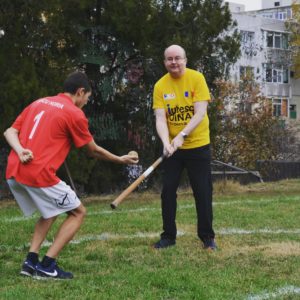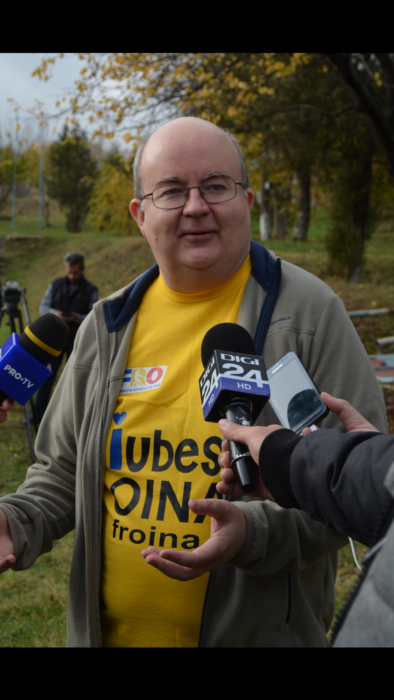16th November 2017
Oina
 Oina is a traditional Romanian sport, whose origins appear to be quite ancient. Some believe that the name derives from the Cuman word for “game”, and it does seem to have a linguistic association with many Turkic languages. Other theories place its origins in shepherding, given its closeness to the Romanian word for sheep. While this is more fanciful, there is nonetheless something in the feel of the game, with players running up one side of the field, before returning down the other, which brings to mind the transhumance of sheep, especially when the batting players are penned in by defensive fielders trying to secure points by throwing the ball direct at them.
Oina is a traditional Romanian sport, whose origins appear to be quite ancient. Some believe that the name derives from the Cuman word for “game”, and it does seem to have a linguistic association with many Turkic languages. Other theories place its origins in shepherding, given its closeness to the Romanian word for sheep. While this is more fanciful, there is nonetheless something in the feel of the game, with players running up one side of the field, before returning down the other, which brings to mind the transhumance of sheep, especially when the batting players are penned in by defensive fielders trying to secure points by throwing the ball direct at them.
Oina as a sport has been linked to Romanian nationalism. It was popularised at the end of the 19th century by the then Education Minister, Spiru Haret, who gave it a place within the Romanian education system. And it was alighted on during this period by the Romanians of Transylvania, still at that time part of Austria-Hungary, as one of the cultural symbols of their drive for greater rights and autonomy. A nationalistic motive was behind the state support for oina in the communist period too. As a reaction to the sport’s associations with communism, oina suffered a sharp decline immediately following the Romanian revolution. But it has been kept alive through the enthusiasm of fans of the game, centred on the Romanian Oina Federation and clubs such as Frontiera Tomis Constanta, and is currently undergoing something of a modest revival.
It is sometimes been suggested in Romania that oina was a source of inspiration for the American game of baseball, brought to the New World by 19th century immigrants from Transylvania, although it seems more likely that baseball derives from the British game rounders. There are though some points of similarity between oina and baseball. Both involve wooden bats (though that used in oina is longer and slimmer than a baseball bat) and a ball of comparable size. Romanian friends have often asked for my views on whether oina might be a distant cousin of cricket. But to me the sports feel very different, with oina having rather more in common with the games of rounders I remember distantly from my childhood.
With thanks to Nicu Dobre, the President of the Romanian Oina Federation, I joined the Frontiera Tomis Constanta and Spicu Horia oina teams on 10 November, for a demonstration match. The Federation’s press release ahead of the event had sparked the interest of the Constanta media. I had never received so much advance publicity for a visit I hadn’t at that point actually undertaken. I duly took to the field, the TV cameras there in force to capture my every sporting gesture. As the oldest and least fit person on the pitch I suspected this would not be flattering.
Our side, consisting of me and some juniors in red from the Spicu Horia team, were put into bat by the formidably fit-looking players of Frontiera Tomis Constanta. Batting started out as a rather reassuring component of oina. Unlike baseball, where the ball is hurled in your direction at great speed by an opponent, in oina it is tossed gently into the air by a team mate for you to swipe at. Two points are secured if you belt it down to the other end of the pitch. I didn’t manage that, but did at least hit the ball a reasonably satisfactory distance.
Having batted the ball, you then wait at the batting end of the pitch for an opportune moment, usually when a team mate hits the ball, to run up the pitch in pairs, running between the defending opponents who are placed at regular intervals across the field. Their geometrical deployment has the effect of forming eight “pens” over the field, with a player at each corner. This proved to be the rather more alarming part of the game, as it transpired that the defending team is able to obtain points by striking the ball at any part of your anatomy. You in turn have to run up the left side of the field to the safe area at the end, and run back again down the right side of the pitch. Your only defence against the ball being thrown at you is first, to try to avoid it, but if this proves impossible, to pat it away with the palm of your hand.

My opponents at Frontiera Tomis Constanta were clearly on their best behaviour, launching the ball at a diplomatically reduced velocity, and mercifully I was not knocked to the ground by any missiles. Nicu Dobre, who was doubling as match referee, with equal diplomacy announced at the end of the event that the result was a 10-10 tie.
I headed off to speak to the press with much less breath that I had been able to muster at the start of the game. I hope the event served to add a little more publicity to the work of the Romanian Oina Federation and to the sport of oina, which deserves to be nurtured both as a fascinating game in its own right and as a part of Romania’s cultural heritage.